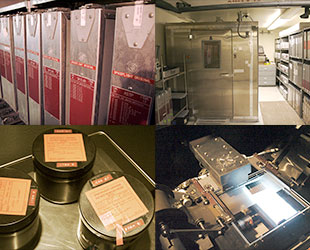August 1, 2007 — If a picture is worth a thousand words, then the 24 astronauts who launched to the Moon almost 40 years ago, returned a tome some 72,000 pages long.
And since their journey from the moon back to the Earth, their collective 36,000 literally-irreplaceable images have remained in deep-freeze storage at NASA Johnson Space Center in Houston, Texas. With only a few exceptions, the majority of the photographs seen by the public have been duplicates made from copies of the originals produced by the space agency between 1968 and 1972.
And like anyone who has duplicated a copy is familiar, the result is never as crystal clear as the original.
It is with that in mind that Arizona State University (ASU) has partnered with NASA to scan the space-flown film in an effort to create a new, high-resolution digital archive for both researchers and the general public on the Internet.
Begun in June 2007 and expected to take three years to complete, the Apollo Image Archive is the first project to produce digital scans of all the lunar photographs — both from orbit and on the surface — captured during NASA's Apollo missions.
"This project fulfills a long-held wish of mine," said Mark Robinson, principal investigator for the camera that will fly on NASA's Lunar Reconnaissance Orbiter, due for launch in October 2008. "It'll give everyone a chance to see this unique collection of images as clearly as when they were taken." Robinson is also a professor at ASU's School of Earth and Space Exploration.
"We worked with the manufacturer of the scanner – Leica Geosystems – to improve the brightness range that the scans record," explained Robinson. In technical terms, a normal 12-bit scan was increased to 14-bit, which resulted in digital images that record more than 16,000 shades of gray.
"Similarly," said Robinson, "to get all the details captured by the film, we are scanning at a scale of 200 pixels per millimeter." As such, the grain of the original film is visible when the scans are fully enlarged.
The most detailed images from lunar orbit show rocks and other surface features about 40 inches (1m) wide. In raw form, the scans of the Apollo mapping frames – each 4.7 inches square – are 1.3 gigabytes in size.
"That is bigger than most people want to look at with a [web] browser," said Robinson, "even if their browser and internet connection are up to the job." So the archive web site uses a Flash-based application called Zoomify, which lets users dive deep into a giant image by loading only the portion being examined.
Users can also download images in several sizes, up to the full raw scan.

From top left: Original flight films inside of the freezer; inside the refrigerator with the freezer on left; Canisters containing original Apollo flight films; Leica DSW700 scanner (normally, lid is kept closed). (Arizona State University) |
When complete, the archive will include about 600 frames in 35 mm, roughly 20,000 Hasselblad 70 mm frames (both in color and black and white), more than 10,000 mapping camera frames and about 4,600 panoramic cam frames.
"These photos have great scientific value, despite being taken decades ago. I think that they also give everybody a beautiful look at this small, ancient world next door to us," Robinson said.
